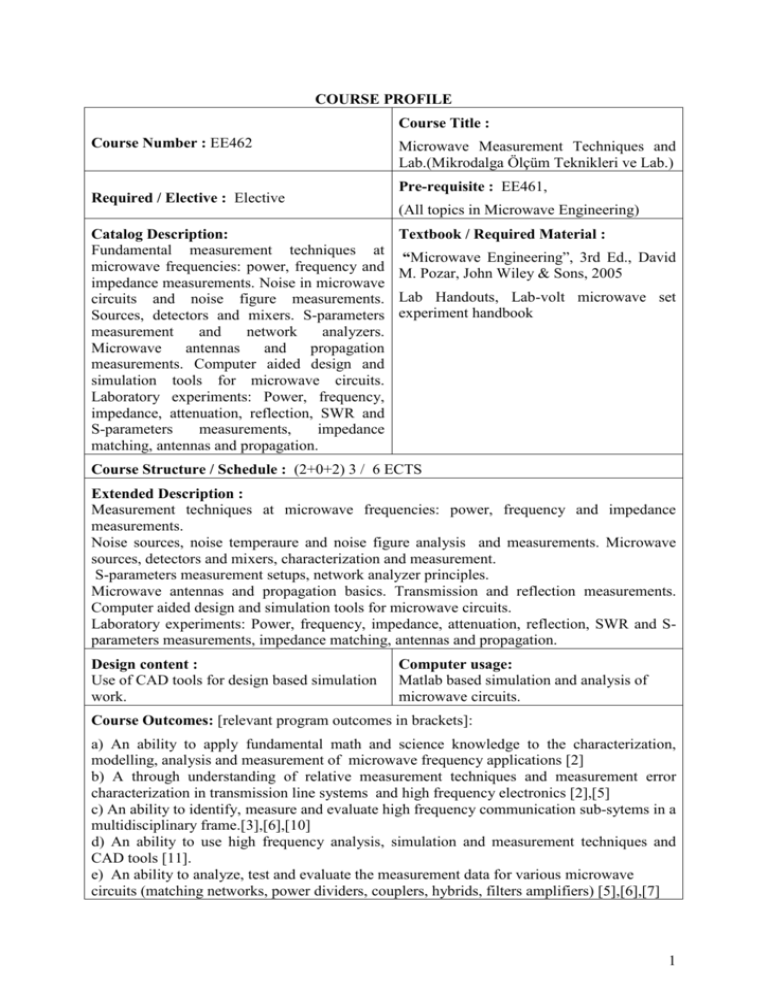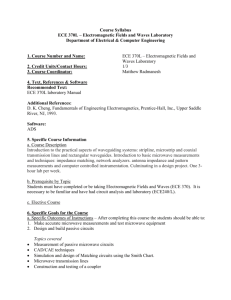EE 462
advertisement

COURSE PROFILE Course Title : Course Number : EE462 Required / Elective : Elective Catalog Description: Fundamental measurement techniques at microwave frequencies: power, frequency and impedance measurements. Noise in microwave circuits and noise figure measurements. Sources, detectors and mixers. S-parameters measurement and network analyzers. Microwave antennas and propagation measurements. Computer aided design and simulation tools for microwave circuits. Laboratory experiments: Power, frequency, impedance, attenuation, reflection, SWR and S-parameters measurements, impedance matching, antennas and propagation. Microwave Measurement Techniques and Lab.(Mikrodalga Ölçüm Teknikleri ve Lab.) Pre-requisite : EE461, (All topics in Microwave Engineering) Textbook / Required Material : “Microwave Engineering”, 3rd Ed., David M. Pozar, John Wiley & Sons, 2005 Lab Handouts, Lab-volt microwave set experiment handbook Course Structure / Schedule : (2+0+2) 3 / 6 ECTS Extended Description : Measurement techniques at microwave frequencies: power, frequency and impedance measurements. Noise sources, noise temperaure and noise figure analysis and measurements. Microwave sources, detectors and mixers, characterization and measurement. S-parameters measurement setups, network analyzer principles. Microwave antennas and propagation basics. Transmission and reflection measurements. Computer aided design and simulation tools for microwave circuits. Laboratory experiments: Power, frequency, impedance, attenuation, reflection, SWR and Sparameters measurements, impedance matching, antennas and propagation. Design content : Use of CAD tools for design based simulation work. Computer usage: Matlab based simulation and analysis of microwave circuits. Course Outcomes: [relevant program outcomes in brackets]: a) An ability to apply fundamental math and science knowledge to the characterization, modelling, analysis and measurement of microwave frequency applications [2] b) A through understanding of relative measurement techniques and measurement error characterization in transmission line systems and high frequency electronics [2],[5] c) An ability to identify, measure and evaluate high frequency communication sub-sytems in a multidisciplinary frame.[3],[6],[10] d) d) An ability to use high frequency analysis, simulation and measurement techniques and CAD tools [11]. e) An ability to analyze, test and evaluate the measurement data for various microwave circuits (matching networks, power dividers, couplers, hybrids, filters amplifiers) [5],[6],[7] 1 f) An ability to use microwave measurement equipment efficiently and setup experiments,[5] g) An ability to work as a team and communicate effectively [9] Level of Contribution of Course to Program Outcomes: Strong: [5],[8],[9], Average: [2],[6], [11] Some : [3],[7],[10] Recommended reading: “RF Circuit Design”, Theory and Applications, R. Ludwig and P. Bretchko, Prentice Hall Teaching Methods: Pre-readings, lectures, Lab experiments, Lab Project, Team work, Assessment Methods: [Related to course outcomes] Lab reports, Midterm/quiz exams, Final exam, Experimental work [a,b,d,e,f,g] Project Presentations, Class survey, [b,c,d,e,f,g] Student Workload: Preparatory reading 45 hrs Lectures 28 hrs Homework 10 hrs Lab 28 hrs Project 32 hrs Presentation 1 hrs Midterm/Quiz Exams 4 hrs Final Exam 2 hrs TOTAL ………………………… 150 hrs … to match 25 x 6 ECTS Prepared by : Prof..Dr. Ahmet Aksen Revision Date : 02.02.2010 2




